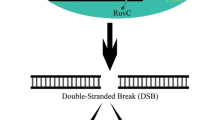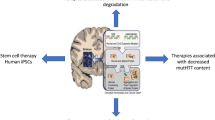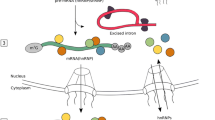Abstract
Huntington’s disease (HD) is caused by an increase in the length of the poly(Q) tract in the huntingtin (Htt) protein, which changes its solubility and induces aggregation. Aggregation occurs in two general phases, nucleation and elongation, and agents designed to block either phase are being considered as potential therapeutics. We demonstrate that inclusion formation can be retarded by introducing modified, single-stranded oligonucleotides into a model neuronal cell line. This cell-based assay is used in conjunction with a standardized biochemical assay to identify molecules that can disrupt the process of aggregate formation. Active oligonucleotides include a 6-mer containing a single phosphorothioate linkage on each terminus, a 53-mer and a 9-mer containing three phosphorothioate linkages at each end, and a 25-mer consisting of all modified RNA residues. The disruption process directed by the active oligonucleotides appears to be independent of sequence specificity and complementarity. In contrast, the activity is more dependent on the type of chemical modifications contained within the oligonucleotide. Some oligonucleotides that demonstrated inhibition activity were also found to extend the life span of PC12 cells after the toxic Htt aggregation process was induced. Our data provide the first evidence that short synthetic oligonucleotides inhibit a fundamental pathological pathway of HD and may provide the basis for a novel therapeutic approach.
Similar content being viewed by others
References
Abraham A. K. (1981) Effect of polyamines on the fidelity of macromolecular synthesis. Med. Biol. 59, 368–373.
Abraham F. F. (1974) Homogeneous Nucleation Theory. Academic Press, New York, NY.
Antony T., Hoyer W., Cherny D., et al. (2003) Cellular polyamines promote the aggregation of alpha-synuclein. J. Biol. Chem. 278, 3235–3240.
Berthelier V., Hamilton J. B., Chen S., and Wetzel R. (2001) A microtiter plate assay for polyglutamine aggregate extension. Anal. Biochem. 295, 227–236.
Braasch D. A. and Corey D. R. (2001) Locked nucleic acid (LNA): fine-tuning the recognition of DNA and RNA. Chem. Biol. 8, 1–7.
Carmichael J., Chatellier J., Woolfson A., et al. (2000) Bacterial and yeast chaperones reduce both aggregate formation and cell death in mammalian cell models of Huntington’s disease. Proc. Natl. Acad. Sci. USA 97, 9701–9705.
Chai Y., Koppenhafer S. L., Bonini N. M., and Paulson H. L. (1999) Analysis of the role of heat shock protein (Hsp) molecular chaperones in polyglutamine disease. J. Neurosci. 19, 10338–10347.
Chen S., Berthelier V., Hamilton J. B., O’Nuallain B., and Wetzel R. (2002a) Amyloid-like features of polyglutamine aggregates and their assembly kinetics. Biochemistry 41, 7391–7399.
Chen S., Berthelier V., Yang W., and Wetzel R. (2001) Polyglutamine aggregation behavior invitro supports a recruitment mechanism of cytotoxicity. J. Mol. Biol. 311, 173–182.
Chen S., Ferrone F. A., and Wetzel R. (2002b) Huntington’s disease age-of-onset linked to polyglutamine aggregation nucleation. Proc. Natl. Acad. Sci. USA 99, 11884–11889.
Cummings C. J. and Zoghbi H. Y. (2000) Fourteen and counting: unraveling trinucleotide repeat diseases. Hum. Mol. Genet. 9, 909–916.
Cummings C. J., Mancini M. A., Antalffy B., et al. (1998) Chaperone suppression of aggregation and altered subcellular proteasome localization imply protein misfolding in SCA1. Nat. Genet. 19, 148–154.
Dagle J. M., Weeks D. L., and Walder J. A. (1991) Pathways of degradation and mechanism of action of antisense oligonucleotides in Xenopus laevis embryos. Antisense Res. Dev. 1, 11–20.
Ferrone F. (1999) Analysis of protein aggregation kinetics. Methods Enzymol. 309, 256–274.
Gilad G. M. and Gilad V. H. (1986) Polyamines affect growth of cultured rat cerebellar neurons in different sera. Int. J. Dev. Neurosci. 4, 195–208.
Heiser V., Engemann S., Brocker W., et al. (2002) Identification of benzothiazoles as potential polyglutamine aggregation inhibitors of Huntington’s disease by using an automated filter retardation assay. Proc. Natl. Acad. Sci. USA 99(Suppl. 4), 16400–16406.
Huang C. C., Faber P. W., Persichetti F., et al. (1998) Amyloid formation by mutant huntingtin: threshold, progressivity and recruitment of normal polyglutamine proteins. Somat. Cell Mol. Genet. 24, 217–233.
Kazantsev A., Preisinger E., Dranovsky A., Goldgaber D., and Housman D. (1999) Insoluble detergent-resistant aggregates form between pathological and nonpathological lengths of polyglutamine in mammalian cells. Proc. Natl. Acad. Sci. USA 96, 11404–11409.
Kazantsev A., Walker H. A., Slepko N., et al. (2002) Abivalent Huntingtin binding peptide suppresses polyglutamine aggregation and pathogenesis in Drosophila. Nat. Genet. 30, 367–376.
Lundqvist A., Noffz G., Pavlenko M., et al. (2002) Nonviral and viral gene transfer into different subsets of human dendritic cells yield comparable efficiency of transfection. J. Immunother. 25, 445–454.
Nagai Y., Tucker T., Ren H., et al. (2000) Inhibition of polyglutamine protein aggregation and cell death by novel peptides identified by phage display screening. J. Biol. Chem. 275, 10437–10442.
Parekh-Olmedo H., Krainc D., and Kmiec E. B. (2002) Targeted gene repair and its application to neurodegenerative disorders. Neuron 33, 495–498.
Ren H., Nagai Y., Tucker T., Strittmatter W. J., and Burke J. R. (2001) Amino acid sequence requirements of peptides that inhibit polyglutamine-protein aggregation and cell death. Biochem. Biophys. Res. Commun. 288, 703–710.
Saeboe-Larssen S., Fossberg E., and Gaudernack G. (2002) mRNA-based electrotransfection of human dendritic cells and induction of cytotoxic T lymphocyte responses against the telomerase catalytic subunit (hTERT). J. Immunol. Methods 259, 191–203.
Sanchez I., Mahlke C., and Yuan J. (2003) Pivotal role of oligomerization in expanded polyglutamine neurodegenerative disorders. Nature 421, 373–379.
Schweitzer E. S. and Paddock S. (1990) Localization of human growth hormone to a sub-set of cytoplasmic vesicles in transfected PC12 cells. J. Cell Sci. 96(Pt. 3), 375–381.
Slotkin T. A. and Bartolome J. (1986) Role of ornithine decarboxylase and the polyamines in nervous system development: a review. Brain Res. Bull. 17, 307–320.
Stein C. A. (1999) Two problems in antisense biotechnology: in vitro delivery and the design of antisense experiments. Biochim. Biophys. Acta 1489, 45–52.
Suhr S. T., Gil E. B., Senut M. C., and Gage F. H. (1998) High level transactivation by a modified Bombyx ecdysone receptor in mammalian cells without exogenous retinoid X receptor. Proc. Natl. Acad. Sci. USA 95, 7999–8004.
Suhr S. T., Senut M. C., Whitelegge J. P., et al. (2001) Identities of sequestered proteins in aggregates from cells with induced polyglutamine expression. J. Cell Biol. 153, 283–294.
Van Tendeloo V. F., Ponsaerts P., Lardon F., et al. (2001) Highly efficient gene delivery by mRNA electroporation in human hematopoietic cells: superiority to lipofection and passive pulsing of mRNA and to electroporation of plasmid cDNA for tumor antigen loading of dendritic cells. Blood 98, 49–56.
Wanker E. E. (2000) Protein aggregation and pathogenesis of Huntington’s disease: mechanisms and correlations. Biol. Chem. 381, 937–942.
Warrick J. M., Chan H. Y., Gray-Board, et al. (1999) Suppression of polyglutamine-mediated neurodegeneration in Drosophila by the molecular chaperone HSP70. Nat. Genet. 23, 425–428.
Warrick J. M., Paulson H. L., Gray-Board et al. (1998) Expanded polyglutamine protein forms nuclear inclusions and causes neural degeneration in Drosophila. Cell 93, 939–949.
Wyatt J. R., Davis P. W., and Freier S. M. (1996) Kinetics of G-quartet-mediated tetramer formation. Biochemistry 35, 8002–8008.
Yang W., Dunlap J. R., Andrews R. B., and Wetzel R. (2002) Aggregated polyglutamine peptides delivered to nuclei are toxic to mammalian cells. Hum. Mol. Genet. 11, 2905–2917.
Author information
Authors and Affiliations
Corresponding author
Rights and permissions
About this article
Cite this article
Parekh-Olmedo, H., Wang, J., Gusella, J.F. et al. Modified single-stranded oligonucleotides inhibit aggregate formation and toxicity induced by expanded polyglutamine. J Mol Neurosci 24, 257–267 (2004). https://doi.org/10.1385/JMN:24:2:257
Received:
Accepted:
Issue Date:
DOI: https://doi.org/10.1385/JMN:24:2:257




